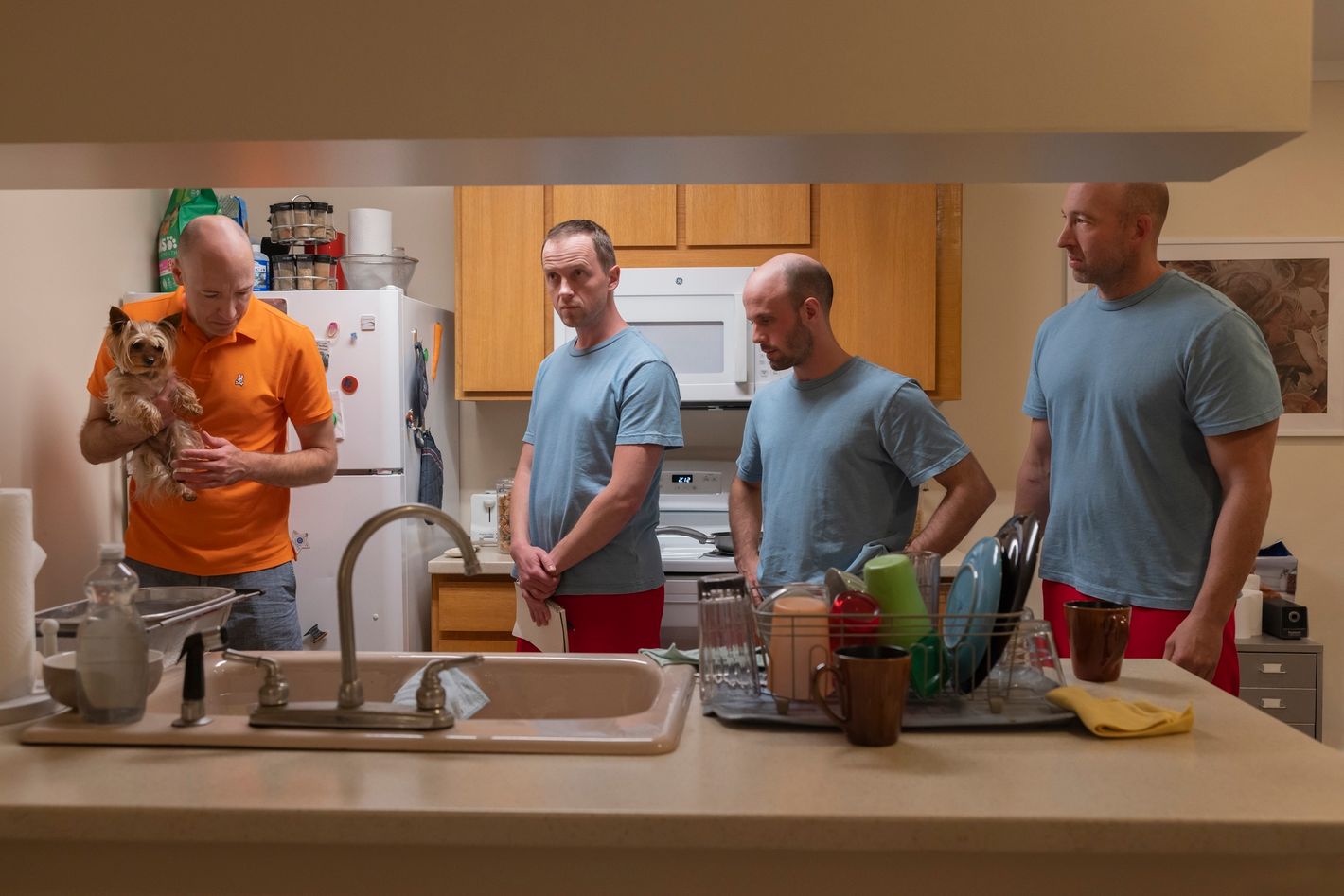

One running joke that consistently lands on The Rehearsal is Nathan Fielder’s willingness to pour HBO’s generous production budget into tiny, seemingly unimportant bits of minutiae to enhance the immersive realism of a given scenario. For example, the dynamic between a captain and a co-pilot in a cockpit could reasonably be rehearsed on an empty stage with two folding chairs rather than on a soundstage that models a terminal in the Houston airport so completely that it has its own Panda Express. But as this season has gotten more hilariously digressive in its social experiments, so has Fielder in pressing for ever-more-absurd attempts at verisimilitude.
Before you can even ask yourself, Wait, what in the world does the behavior of a cloned puppy have to do with improving communication between pilots?, Fielder is out there fussing over how to make Los Angeles’s exteriors approximate San Jose in the year 2011. The altitude is roughly the same, which is a major shift from the mile-high environs of the dog’s home in a Colorado suburb, but the air itself might be a little different. This was “easy to match,” Fielder notes, “by regularly collecting San Jose air using a compressor and transporting it 350 miles via truck to L.A.” On his daily walks, the dog could then sniff in that air along with period-specific conversations from the tech moguls who might be walking by in San Jose in the morning. (“So sad about Steve Jobs.” “A legend, right?”) The dog may not have much appreciation for, say, a vintage Subway ad featuring now-disgraced sex offender Jared Fogle, but you can never guess which details matter.
But let’s back up a bit. The Rehearsal had spent the first couple of episodes focusing mostly on co-pilots and their need to assert themselves more in situations where the captain’s judgment might be impaired. However, as Fielder has noted many times, the co-pilots don’t often feel comfortable speaking up when the captain has created an environment in which there are negative consequences for doing so. “Pilot’s Code” is about Fielder’s left-field attempts to address the captain’s side of the equation, starting with an effort to match the behavior of a cloned puppy named Zeus with that of his genetic source, Achilles. It’s the ideal way to test the nature-versus-nurture question: If Zeus is exactly like Achilles in genetic makeup, their differences must be entirely because of the nurture side of the equation. So if Fielder and his team can re-create the conditions in which Achilles was raised, then the dog will surely act like the affectionate creature its owners desire.
To that end, Fielder collaborates with Monique and Bogdan, a couple who had the resources to clone Achilles ($50,000!) and got three new puppies for their troubles. But the clones so far don’t act like the original, which Fielder chalks up to an entirely new set of living conditions: a spacious home in Colorado rather than a cramped apartment in San Jose and a domestic situation that has changed a bit, too, since Bogdan was off doing tech work while Monique spent much of her time at home with the dog. With his own acting clones applying “the Fielder Method” on Bogdan and Monique — he has three actors per person working shifts at the L.A. studio — young Zeus gets a chance to be raised like Achilles and perhaps engineered into an animal that might respond more sympathetically to Monique’s occasional diabetic attacks. As the weeks go by and changes don’t appear to be happening, Fielder and his actors add some domestic tension to the mix, too, with fake-Bogdan screaming to fake-Monique about microprocessors and ditching her to see The Hangover Part II with his buddies.
A mild breakthrough with Zeus mimicking house cats, as Achilles once did, isn’t enough to move the needle for Fielder, who then makes an even more dramatic shift in behavioral modeling. What if, instead of officious louts like Jeff, the captain who had been kicked off every dating app, pilots could be more like Chesley “Sully” Sullenberger, the aviator famous for saving the lives of everyone aboard US Airways Flight 1549 in early 2009 when a bird strike disabled the engines after takeoff and he made an emergency landing on the Hudson River? The flight transcript indicates that Sully solicited the opinion of his co-pilot before making such a drastic decision, which is exactly what Fielder wanted to achieve. He’s so dedicated to this mission, in fact, that he’s willing to turn himself into a giant Sully baby choking down oceans of milk from the nipples of a puppet version of Sully’s mother.
In my recap of the first episode, I talked about Charlie Kaufman’s Synecdoche, New York being a possible influence on Fielder’s show, specifically his impulse to keep adding new bits of scaffolding to an endlessly expansive project. But the puppetwork in “Pilot’s Code” recalls another Kaufman film, Being John Malkovich, which has a lowly puppeteer for a hero and at one point features a rival dazzling the masses with a 60-foot-tall Emily Dickinson. “Look, what you’re about to witness is going to seem weird,” deadpans Fielder as he shaves his entire body from head to toe with an electric razor, “which is why I’m putting myself through it before I invite any pilots to participate.” If he can become Sully, just as Zeus (sort of) became Achilles, then maybe it can work on other pilots. Maybe if Jeff has to wear a diaper and choke on mother’s milk, he’ll not only be a better pilot but a better dating partner, too.
The scenes of “Pilot’s Code” in which Fielder acts out sections of Sully’s memoir are the most inspired of the episode, from a childhood incident where his little-boy Sully feeds his grotesque little sister stones to an awkward “sensual” memory of a teenage Sully taking a would-be girlfriend on an intimate flight. Fielder’s assumption about the latter scene is that young Sully was “aroused,” which made him have to compartmentalize his raging hormones in order to guide the plane safely through the air. And if that means Fielder has to replace the actress playing Sully’s companion with a robot, dismiss the crew from the set, and masturbate in front of cameras placed on tripods, then those are reasonable sacrifices to be made for science and art.
However, Fielder seems to concede that certain behaviors are more mysterious and elusive than even his experiment can access. Might the 23-second chorus to the 2003 Evanescence hit “Bring Me to Life” be responsible for putting Sully in the proper headspace to land that plane? Food for thought.
Scene Work
• “No matter how many times she pretended to die, Zeus didn’t care at all.”
• That thing when a small dog mimics the behavior of a cat by walking across the top of a couch? That’s definitely not Achilles-specific. My old pug used to do that all the time.
• Fielder’s dumbfounded expression when Jeff the pilot talks about the “T-girls” who fooled him repeatedly on the dating apps is highly relatable.
• “It was difficult at first to inhabit the mind of a baby. I know so much more than babies do, and it can be hard to forget all that stuff. So I tried not to think about the fact that I was a 41-year-old man and just did my best to be present in the moment.” Cue breastfeeding scene.
• The broadness of the episode’s period-specific references is a treat in itself, like Monique and Bogdan sitting down at the beginning to clips of the royal wedding and Obama announcing the Osama bin Laden killing — or the year 2002 being presented by a beeping clock from 24 and an ad for the iPod.
• The final stretch of the episode deals with “coping” strategies, which is how Evanescence comes in. But it makes the nuanced point that even a pilot as by the book as Sully isn’t inhuman and “it’s okay to admit you can’t do everything.” Pilots could use a little therapy, too.

Latest News
For Sale! 2016 Sea Ray 350 Sundancer – $180,000
Reel Deal Yacht is pleased to feature a meticulously maintained 2016 Sea...
Indulge in Luxury Living at the Upcoming Wine & Design Event
Experience Luxury Living at the Final Spring Wine & Design Event On...
Club Offers Announced on May 18, 2025
Travelzoo Unveils Exclusive Club Offers for Travel Enthusiasts LONDON, May 17, 2025...
Promoter’s Caution could add random layer of chaos in NASCAR All-Star Race
The fate of the NASCAR All-Star Race largely rests on the whims...
Caitlin Clark says flagrant foul for shoving Angel Reese was not ‘malicious’
Caitlin Clark and Angel Reese agreed on one thing Saturday: Their minor...













Leave a comment